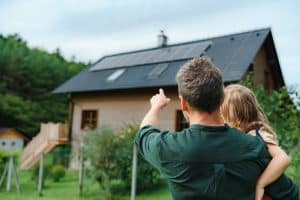4 Ways Your Home Can Be in Harmony With the Environment
Are you building a new home, renovating a home, redesigning your interior space or building a new addition? Before you get started, you should be aware that most traditional building and design processes are harmful to the environment.
What about planting a garden? That may seem like an easy way to add beauty to your home and live in tune with the environment. Even planting a garden can have environmental impacts if it isn’t designed for the local environment. There are many popular garden plants that could be poisonous to animals, invasive or non-native to the environment, requiring excessive water.
With a quick home and garden audit or ecosystem integration consultation, your home and garden can be redesigned to be in harmony with nature.
Here are 4 ways to rethink your design project so it doesn’t clash with the local environment:
1. Adapt to the local climate.
Keeping warm or staying cool in your home should not depend on cranking up the heat or AC. With conscious design and green interior design, you can build your home along sustainable lines or redesign your home or space to allow for adapting to the local climate. Some examples of design choices that can reduce bills, save energy and make materials last longer include deciding on the orientation of the house based on wind direction and sunlight, situating common areas where there is a lot of natural light and building with materials suited to the climate. Some materials, like stone floors, which conduct heat and stay cool in the summer, work best for a hotter climate. A green roof can reduce carbon in the air, insulate a roof from heat and cool down the air around it. In most homes, there is the option to install solar photovoltaic panels.
2. Show consideration for the local flora and fauna.
Wherever you build your house or settle, there will be non-human creatures who share your environment. The principles of non-violent design dictate that non-human animals should have parity with humans. We should live as if our neighbors include animals who don’t share our language but do share our space.
The local flora matters too. Some common plants are invasive and can harm the local environment. If you are living in a suburban area, being mindful of your animal neighbors could include securing your trash so that animals won’t be drawn to it and making sure that the plants that you grow are not poisonous to animals or birds. Never use pesticides that can harm local bugs. You can grow plants to attract local pollinators. In a more delicate ecosystem you may need to be careful not to introduce non-native plants that will easily seed and overrun local flora. Don’t grow non-native plants that would waste excessive water if you live in a dry climate. You should also secure any drains and prevent waste or runoff from your home entering the water supply and affecting the health plants and wild animals.
3.Use green building materials and methods.
Many building and decorating practices are harmful to the environment and to health. You should work with suppliers who can build and redecorate using less harmful practices. Sealants, insulation, fire retardants and paints can very often be toxic. Low VOC or no VOC (Volatile Organic Compounds) paint can be used in the home to reduce exposure to the chemicals that evaporate from paints and cause harm to health. Insulating materials and methods of installing insulation now offer greener alternatives that can be installed without the harmful “off-gassing” of spray-foam insulation.
4. Use interior furnishings that are cruelty-free and sustainably produced.
Instead of going to a furniture retail outlet, consider buying home furnishings from local suppliers or indigenous collectives that fairly compensate their workers and support traditional crafts and local materials. There may be creative ways to upcycle too, such as creating furniture or furnishings from reclaimed wood, second hand pieces of furniture, recycled paper and older textiles. Avoiding any leather products, silk or wool spares animals from cruelty. These production processes are also chemically intensive and damage the environment. You can also search for verified sustainable materials like wood that has been verified by the sustainable forestry initiative.
Green home design always incorporates the local environment into your home design. When you do a green interior design consultation or ecosystem integration consultation on your home-build or home and garden design, our designers always want to know about the local environment where you live. We do thorough research about the impact on local flora and fauna and how to use the most sustainably sourced materials that are harmonious with the local environment and the landscape. At Earth Science Design we have spent over 10 years researching the science of green interior design and sustainable design. We bring our eco-sensitive expertise to every project and we can connect you with ethical suppliers who can realize your vision of a beautiful sustainable home. Our La Jolla interior design services are available in person or remotely depending on your convenience. Please contact us to learn more.


